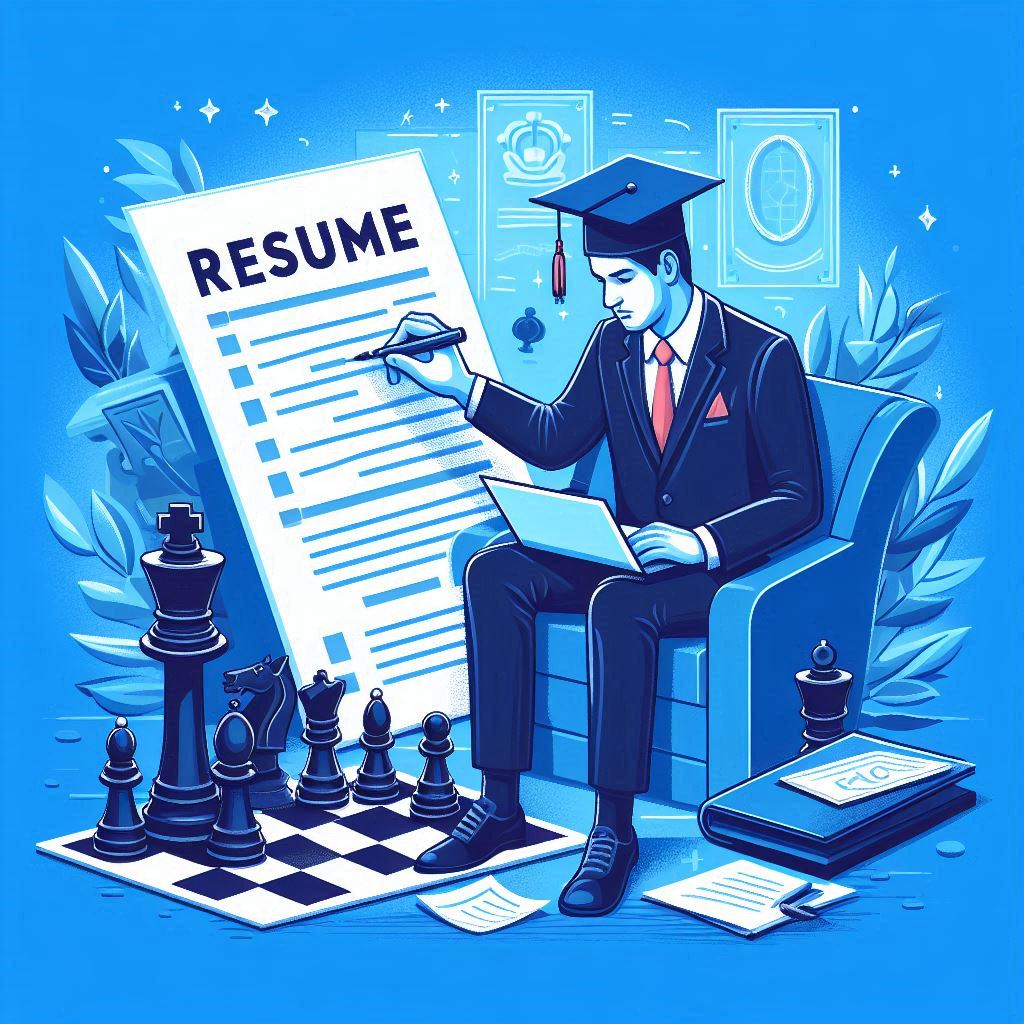Editor's Pick
Fresh Graduate Resume Guide 2024: How to Write Your First Professional Resume That Gets You Hired
The complete guide to writing your first professional resume as a fresh graduate in 2024. Learn how to transform academic achievements into compelling professional value, optimize for ATS systems, and avoid the critical mistakes that disqualify 95% of new graduate applications. Includes proven formatting strategies, industry-specific examples, and step-by-step templates designed specifically for entry-level candidates.
Discover how to position yourself as a solution-ready professional rather than just another hopeful graduate, with actionable strategies that help you compete effectively against 118+ other applicants for every entry-level position.
Fresh Graduate Resume Guide 2024: How to Write Your First Professional Resume That Gets You Hired
The Fresh Graduate Resume Challenge: Why 95% Get It Wrong
You've spent years mastering your field of study, but now you face a new challenge: competing against 118 other applications for every entry-level position. The brutal reality? Most fresh graduates create resumes that immediately disqualify them from consideration.
Here's what hiring managers actually see in typical fresh graduate resumes:
Generic templates that look identical to every other candidate
Academic focus without demonstrating real-world readiness
Missing keywords that cause ATS rejection before human review
Poor formatting that makes scanning difficult for busy recruiters
Weak positioning that fails to communicate unique value
But here's the opportunity: employers plan to hire 14.7% more new graduates this year. Companies are actively seeking fresh talent with the right skills and potential. The key is presenting yourself as the solution they're looking for, not just another recent graduate hoping for a chance.
🎯 Skip the Learning Curve
Building a professional resume from scratch takes weeks of research, formatting, and optimization. Our fresh graduate resume templates are specifically designed for new grads, with proven formats that get past ATS systems and impress hiring managers.
→ Get Your Professional Resume Template Now
This guide will show you exactly how to transform your academic achievements into a compelling professional narrative that gets you hired. You'll learn the specific strategies that work for fresh graduates, complete with templates and examples that you can implement immediately.
Fresh Graduate Resume Strategy: Your Competitive Advantage
Unlike experienced professionals who rely on work history, your resume strategy centers on potential and preparation. Employers hiring fresh graduates look for three key indicators:
1. Learning Agility and Skill Development
Demonstrate how quickly you acquire new competencies and apply them effectively. Employers want graduates who can hit the ground running and continue growing within their organization.
2. Real-World Application of Knowledge
Show how you've applied classroom learning to practical situations through internships, projects, volunteer work, or personal initiatives that produced measurable results.
3. Cultural Fit and Professional Readiness
Prove you understand professional environments and can contribute positively to team dynamics while adapting to organizational culture.
The Fresh Graduate Value Proposition
Your resume should answer this question: "Why should we hire you over 117 other qualified candidates?"
Successful fresh graduate resumes focus on:
Relevant technical skills gained through coursework and practical application
Leadership experience from student organizations, volunteer work, or team projects
Problem-solving abilities demonstrated through academic projects or internships
Industry awareness showing understanding of current trends and challenges
Professional communication evidenced through presentations, writing, or client interaction
The Optimal Fresh Graduate Resume Format
The right format can make the difference between interview invitations and rejection emails. Here's the proven structure that works for fresh graduates:
The Combination Format: Why It Works
Fresh graduates should use a combination format that emphasizes skills while showcasing relevant experience:
Section-by-Section Breakdown
Professional Summary (30-50 words)
Your opening statement should immediately position you as a qualified candidate:
✅ Strong Example: "Recent Computer Science graduate with 3+ years of programming experience and internship background in full-stack development. Proven ability to deliver scalable solutions through academic projects serving 500+ users. Seeking to leverage technical skills and innovative problem-solving in a Software Developer role."
Core Competencies (Skills Section)
Organize skills into 2-3 categories with specific examples:
Education Section Enhancement
Make your education work harder by highlighting relevant details:
📋 Fresh Graduate Resume Templates
Choose from 10+ professionally designed templates created specifically for new graduates. Each template includes optimized sections, ATS-friendly formatting, and industry-specific examples to guide your content.
→ Access Fresh Graduate Templates
Transforming Academic Experience Into Professional Value
The biggest challenge for fresh graduates is translating academic achievements into professional qualifications. Here's how to make that transformation:
The Experience Translation Framework
1. Internships: Your Professional Foundation
Present internships as genuine professional experience:
2. Academic Projects as Professional Experience
Transform significant projects into experience entries:
3. Leadership Roles and Extracurriculars
Position student leadership as management experience:
Quantifying Academic Achievements
Add measurable impact to your academic experiences:
Comparison Examples:
Weak Statement: "Wrote research paper" Strong Statement: "Authored 25-page research analysis cited by 3 subsequent academic studies"
Weak Statement: "Good student" Strong Statement: "Maintained 3.8 GPA while working 20 hours/week and leading student organization"
Weak Statement: "Helped classmates" Strong Statement: "Tutored 12 students in advanced statistics, improving average class grades by 15%"
Weak Statement: "Gave presentations" Strong Statement: "Delivered 8+ presentations to audiences of 50+ including final defense to industry panel"
Fresh Graduate Resume Sections That Win Interviews
Certain sections can dramatically improve your competitiveness as a fresh graduate:
Projects Section: Showcase Applied Learning
Create a dedicated projects section to highlight practical applications:
Certifications and Continuous Learning
Show commitment to professional development:
Relevant Coursework That Matters
Highlight courses that directly prepare you for your target role:
ATS Optimization for Fresh Graduates
Fresh graduate resumes face unique ATS challenges. Here's how to optimize for automated screening:
Fresh Graduate Keyword Strategy
Target keywords that matter for entry-level positions:
Universal Fresh Graduate Keywords
Educational qualifications: "Bachelor's degree," "recent graduate," "academic projects"
Learning indicators: "coursework," "training," "certification," "self-directed learning"
Potential markers: "entry-level," "junior," "associate," "trainee programs"
Soft skills: "teamwork," "communication," "problem-solving," "adaptability"
Industry-Specific Keyword Examples
Technology: Junior Developer, Programming Languages, Version Control, Agile, APIs, Debugging
Marketing: Digital Marketing, Social Media, Content Creation, Analytics, Campaign Management, SEO
Finance: Financial Analysis, Excel, Financial Modeling, Investment Banking, Corporate Finance
Consulting: Business Analysis, Strategy, Client Relations, Presentation Skills, Problem Solving
ATS-Friendly Formatting Rules
Use standard section headers: "Education," "Experience," "Skills" (not creative alternatives)
Include both degree abbreviations and full names: "BS Computer Science" and "Bachelor of Science"
List skills in multiple formats: "JavaScript" and "Java Script"
Use simple bullet points: Avoid fancy symbols or graphics
Save as .docx format: Most ATS systems prefer Word documents
Common Fresh Graduate Resume Mistakes (And How to Fix Them)
Avoid these pitfalls that immediately disqualify fresh graduate resumes:
Mistake #1: Academic Resume Mentality
❌ Wrong Approach: "Dean's List student with extensive coursework in business fundamentals. Completed all required classes with high grades. Seeking opportunity to learn and grow in a professional environment."
✅ Professional Approach: "Business graduate with proven analytical and project management skills demonstrated through leading $50K budget optimization project. Combines academic excellence (3.8 GPA) with practical experience managing cross-functional teams and delivering measurable results."
Mistake #2: Generic Objectives
❌ Generic: "Seeking a challenging position where I can utilize my skills and grow professionally."
✅ Specific: "Data Science graduate seeking to apply machine learning expertise and statistical analysis skills in a Business Intelligence Analyst role, with demonstrated ability to extract actionable insights from complex datasets."
Mistake #3: Underselling Part-Time Experience
❌ Undersold: "Server at restaurant. Took orders and served food."
✅ Professional:
"Customer Service Representative | High-Volume Restaurant
• Managed 20+ customer interactions per hour in fast-paced environment, maintaining 95% satisfaction rating
• Collaborated with kitchen and management teams to resolve service issues, reducing complaint escalations by 30%
• Trained 3 new employees on customer service protocols and POS system operation"
⚡ Professional Resume Transformation
Our AI-powered resume builder automatically transforms academic language into professional terminology, suggests powerful action verbs, and helps you quantify achievements for maximum impact.
→ Transform Your Resume Professionally
Mistake #4: Poor Skills Organization
❌ Weak Skills List: "Microsoft Office, teamwork, communication, leadership, problem-solving, organized, hardworking, reliable, Excel, PowerPoint"
✅ Professional Skills Organization:
Your Fresh Graduate Resume Action Plan
Transform your resume from academic document to professional marketing tool with this step-by-step plan:
Week 1: Foundation and Research
Inventory your experiences: List all internships, projects, leadership roles, and achievements
Research target roles: Analyze 10+ job descriptions to identify common requirements
Choose your format: Select combination format template optimized for fresh graduates
Draft professional summary: Write 2-3 versions targeting different role types
Week 2: Content Development
Transform experiences: Convert academic projects into professional experience entries
Quantify achievements: Add metrics and results to every bullet point possible
Optimize skills section: Organize by relevance and include proficiency indicators
Create projects section: Highlight 2-3 most impressive academic or personal projects
Week 3: Optimization and Testing
ATS optimization: Integrate relevant keywords throughout your resume
Professional formatting: Ensure clean, scannable design with consistent styling
Get feedback: Share with career services, mentors, and industry contacts
Create variations: Develop 2-3 targeted versions for different industries
Success Metrics to Track
Application-to-response ratio: Target 15-20% response rate
Phone screen conversion: Aim for 30%+ of responses leading to interviews
Interview feedback: Note which sections generate the most questions
Offer conversion: Track final interview to offer ratios
🚀 Ready to Launch Your Career?
Stop struggling with formatting, keyword optimization, and content strategy. Our fresh graduate resume builder creates professional resumes that get results.
What makes our templates perfect for new graduates:
✅ Specifically designed for fresh graduates with limited experience
✅ ATS-optimized formatting that passes automated screening
✅ Professional language suggestions to transform academic achievements
✅ Industry-specific templates for your target field
✅ Built-in examples and guidance for every section
✅ Real-time optimization suggestions as you build
→ Create Your Professional Resume Now
Free templates available • No experience required • Start your career strong
Your First Professional Resume: The Foundation of Career Success
Your resume as a fresh graduate isn't just a document—it's your introduction to the professional world and the foundation of your career trajectory. The principles and strategies in this guide will help you create a resume that not only gets you interviews but positions you for long-term success.
Key takeaways for fresh graduate resume success:
Strategic positioning: Present yourself as a prepared professional, not just a recent student
Value-focused content: Emphasize what you can contribute, not what you hope to learn
Professional language: Transform academic experiences into business-relevant achievements
Quantified results: Use numbers and metrics to demonstrate impact wherever possible
ATS optimization: Ensure your resume passes automated screening systems
Targeted approach: Customize your resume for each application and industry
Remember that your first professional resume is a learning document. As you gain experience and clarity about your career direction, you'll refine and enhance it. But starting with a strong foundation—one that presents you as a competent, prepared professional—sets the stage for interview success and career growth.
The job market for fresh graduates is competitive, but it's also full of opportunity. Companies need fresh talent with current skills and innovative perspectives. By presenting yourself strategically and professionally, you'll stand out from the crowd and launch your career with confidence.
Your career journey starts with your first professional resume—make it count.
© 2024 1Template. All rights reserved.
Your first professional resume is more than just a summary of your academic achievements—it's your ticket to launching a successful career. By transforming your educational experiences into compelling professional narratives, optimizing for both ATS systems and human reviewers, and positioning yourself as a solution-ready candidate rather than just another hopeful graduate, you'll stand out in a competitive market.
The difference between graduates who land great jobs and those who struggle isn't talent or grades—it's how effectively they communicate their value to employers. With the strategies in this guide, you have everything you need to create a resume that opens doors and starts conversations.
Your career begins with that first "yes" from an employer. Make sure your resume gives them every reason to say it.
Build your own resume with 1template
Build your resume in 60 seconds with the most advanced AI-powered builder








